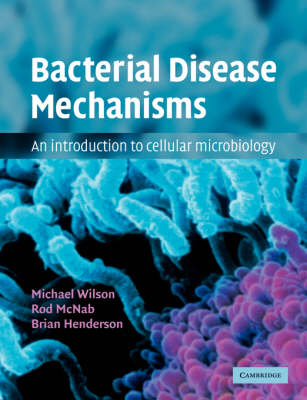
Bacterial Disease Mechanisms
Cambridge University Press (Verlag)
978-0-521-79689-7 (ISBN)
Antibiotic resistance and our consequent inability to treat many bacterial infections had fuelled an urgent need to understand the means by which bacteria cause disease. This has lead to a renaissance in research into bacterial disease mechanisms and the birth of a new discipline - cellular microbiology. The fruits of such research and how they have lead to an alternative perspective on bacteria-host interactions are described in this introductory textbook. The central premise is that bacteria have evolved means of manipulating normal host cell functions and overcoming host defence systems to ensure their survival. As well as offering an interesting perspective on the classical bacterial virulence mechanisms, this book outlines the molecular techniques developed to unravel the complexity of bacteria-host interactions. Research may lead not only to a better understanding of disease mechanisms, but also to alternative means of preventing and/or treating bacterial infections.
Michael Wilson is currently Professor of Microbiology in the Faculty of Clinical Sciences, University College London, and Head of the Department of Microbiology at the Eastman Dental Institute, University College London. He is the co-editor of Community Structure and Co-operation in Biofilms, 2000 (0521793025) and editor of Bacterial Adhesion to Host Tissues, 2001 (0521801079). His main research interests are bacterial virulence factors, biofilms and the development of new antimicrobial strategies. Brian Henderson is Professor of Cell Biology and Head of the Cellular Microbiology Research Group at the Eastman Dental Institute, University College London. His research centres around cytokine biology and the interactions of bacteria with myeloid and lymphoid cells. Rod McNab is Lecturer in Molecular Microbiology at the Eastman Dental Institute, University College London, and works on streptococcal adhesion and colonization factors, biofilms and bacterial cell-cell communication.
Preface; Abbreviations used; 1. An introduction to bacterial diseases; 2. Bacterial cell biology; 3. Molecular analysis of bacterial virulence mechanisms; 4. Communication in infection; 5. The mucosal surface: the front line of antibacterial defence; 6. Immune defences against bacteria; 7. Bacterial adhesion as a virulence mechanism; 8. Bacterial invasion as a virulence mechanism; 9. Bacterial exotoxins; 10. Bacterial evasion of host defence mechanisms; 11. Bacteria in human health and disease: the future?; Appendix A. Glossary of terms used; Appendix B. Brief descriptions of bacteria frequently mentioned; Index.
| Erscheint lt. Verlag | 18.4.2002 |
|---|---|
| Zusatzinfo | 131 Tables, unspecified; 1 Plates, color; 64 Halftones, unspecified; 203 Line drawings, unspecified |
| Verlagsort | Cambridge |
| Sprache | englisch |
| Maße | 184 x 250 mm |
| Gewicht | 1220 g |
| Themenwelt | Medizin / Pharmazie ► Medizinische Fachgebiete ► Mikrobiologie / Infektologie / Reisemedizin |
| Studium ► Querschnittsbereiche ► Infektiologie / Immunologie | |
| Naturwissenschaften ► Biologie ► Mikrobiologie / Immunologie | |
| Naturwissenschaften ► Biologie ► Zellbiologie | |
| Technik ► Umwelttechnik / Biotechnologie | |
| ISBN-10 | 0-521-79689-X / 052179689X |
| ISBN-13 | 978-0-521-79689-7 / 9780521796897 |
| Zustand | Neuware |
| Haben Sie eine Frage zum Produkt? |
aus dem Bereich


